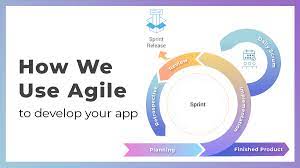The Agile Scrum Model in Software Engineering
In software engineering, the Agile Scrum model is a popular framework used to manage and develop software projects. It is based on the principles of agility and collaboration, allowing teams to work in an iterative and incremental manner.
The Agile Scrum model consists of several key components, including:
- Sprints: The project is divided into short iterations called sprints, usually lasting 2-4 weeks. Each sprint focuses on delivering a working product increment.
- Scrum Team: The team consists of cross-functional members, including developers, testers, designers, and product owners. They work together to deliver the product.
- Product Backlog: A prioritized list of features or requirements that need to be implemented in the product. It is constantly updated throughout the project.
- Sprint Planning: At the beginning of each sprint, the team plans the work that needs to be done and commits to delivering a set of features by the end of the sprint.
- Daily Stand-ups: Short daily meetings where team members discuss their progress, any obstacles they are facing, and plan their work for the day.
- Sprint Review: At the end of each sprint, a review meeting is held where the team demonstrates the completed work to stakeholders and receives feedback.
- Retrospective: A meeting held after each sprint to reflect on what went well, what could be improved, and how to make adjustments for future sprints.
The Agile Scrum model promotes flexibility, adaptability, and continuous improvement throughout the software development process. By breaking down complex projects into manageable chunks and focusing on delivering value in short iterations, teams can respond quickly to changes and deliver high-quality products efficiently.
Overall, the Agile Scrum model has become increasingly popular in software engineering due to its emphasis on collaboration, transparency, and customer satisfaction. It allows teams to deliver valuable software products that meet customer requirements effectively and efficiently.
6 Essential Tips for Mastering Agile Scrum in Software Engineering
- Hold daily stand-up meetings to keep the team updated on progress and any obstacles.
- Break down tasks into smaller, manageable units to improve efficiency and transparency.
- Prioritize collaboration and communication within the team to ensure everyone is aligned.
- Regularly review and adapt processes for continuous improvement in product development.
- Empower teams to make decisions collectively, fostering a sense of ownership and accountability.
- Use sprint retrospectives to reflect on what went well and what could be improved for future sprints.
Hold daily stand-up meetings to keep the team updated on progress and any obstacles.
In the Agile Scrum model in software engineering, holding daily stand-up meetings is a key practice to ensure that team members stay informed about project progress and any obstacles they may be facing. These short and focused meetings provide an opportunity for team members to discuss their work, share updates, and collaborate on solutions to challenges in a timely manner. By maintaining open communication through daily stand-ups, teams can stay aligned, address issues promptly, and maintain momentum towards achieving project goals effectively.
Break down tasks into smaller, manageable units to improve efficiency and transparency.
Breaking down tasks into smaller, manageable units is a key tip in the Agile Scrum model of software engineering. By dividing work into smaller chunks, teams can improve efficiency and transparency in their projects. This approach allows for better tracking of progress, easier identification of potential roadblocks, and more accurate estimation of timelines. Additionally, breaking down tasks helps team members stay focused and motivated as they work towards completing each unit, leading to a smoother and more successful project delivery overall.
Prioritize collaboration and communication within the team to ensure everyone is aligned.
In the Agile Scrum model in software engineering, prioritizing collaboration and communication within the team is essential to ensure that everyone is aligned and working towards a common goal. By fostering open communication and encouraging collaboration, team members can share ideas, address challenges, and work together effectively to deliver high-quality software products. Clear and consistent communication helps to prevent misunderstandings, promotes transparency, and enhances overall team productivity. Emphasizing collaboration within the team not only improves project outcomes but also fosters a positive work environment where individuals feel valued and supported in their efforts.
Regularly review and adapt processes for continuous improvement in product development.
In the Agile Scrum model in software engineering, it is essential to regularly review and adapt processes to ensure continuous improvement in product development. By consistently evaluating the effectiveness of current practices and making necessary adjustments, teams can enhance efficiency, productivity, and overall product quality. This iterative approach allows for flexibility and agility in responding to changing requirements and market demands, ultimately leading to better outcomes and increased customer satisfaction.
Empower teams to make decisions collectively, fostering a sense of ownership and accountability.
Empowering teams to make decisions collectively in the Agile Scrum model is a crucial tip in software engineering. By encouraging collaboration and shared responsibility, team members feel a sense of ownership and accountability for the project’s success. This approach not only boosts morale and motivation but also leads to more innovative solutions as team members bring diverse perspectives and expertise to the decision-making process. Ultimately, fostering a culture of collective decision-making enhances team dynamics and drives better outcomes in software development projects.
Use sprint retrospectives to reflect on what went well and what could be improved for future sprints.
Sprint retrospectives are a valuable practice in the Agile Scrum model of software engineering. By taking the time to reflect on what went well and what could be improved for future sprints, teams can identify strengths and weaknesses in their processes. This reflection allows teams to make adjustments, address challenges, and continuously improve their work. Sprint retrospectives foster a culture of learning and growth within the team, leading to increased efficiency, productivity, and overall success in delivering high-quality software products.



